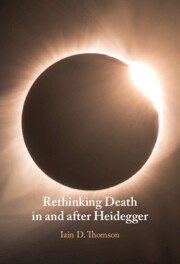Refine search
Actions for selected content:
121 results
2 - Medical Progress as Biomedical Knowledge Gains
-
- Book:
- Making Medical Progress
- Published online:
- 12 December 2025
- Print publication:
- 20 November 2025, pp 66-103
-
- Chapter
-
- You have access
- Open access
- HTML
- Export citation
1 - Fashion, Post-postmodernism and Intellectual Property
- from Part I - Theoretical Frameworks
-
-
- Book:
- Fashion and Intellectual Property
- Published online:
- 27 October 2025
- Print publication:
- 13 November 2025, pp 3-48
-
- Chapter
-
- You have access
- Open access
- HTML
- Export citation
31 - Twentieth-Century Czech Female Composers in Cultural and Political Context: The Pre-1989 Music of Ivana Loudová and Sylvie Bodorová
- from Part III - The Twentieth Century and Beyond
-
-
- Book:
- A History of Music in the Czech Lands
- Published online:
- 21 October 2025
- Print publication:
- 16 October 2025, pp 436-449
-
- Chapter
- Export citation
Epilogue
- from Part II - Themes and Issues
-
-
- Book:
- The Cambridge Companion to Modernist Theatre
- Published online:
- 28 August 2025
- Print publication:
- 11 September 2025, pp 302-312
-
- Chapter
- Export citation
Chapter 4 - The Geographies of British Postmodern Fiction
-
-
- Book:
- The Cambridge Companion to British Postmodern Fiction
- Published online:
- 07 August 2025
- Print publication:
- 21 August 2025, pp 66-81
-
- Chapter
- Export citation
Chapter 13 - Neo-Victorian Fiction
-
-
- Book:
- The Cambridge Companion to British Postmodern Fiction
- Published online:
- 07 August 2025
- Print publication:
- 21 August 2025, pp 206-223
-
- Chapter
- Export citation
Chapter 11 - Black British and British Asian Fiction
-
-
- Book:
- The Cambridge Companion to British Postmodern Fiction
- Published online:
- 07 August 2025
- Print publication:
- 21 August 2025, pp 174-190
-
- Chapter
- Export citation
Introduction
-
-
- Book:
- The Cambridge Companion to British Postmodern Fiction
- Published online:
- 07 August 2025
- Print publication:
- 21 August 2025, pp 1-17
-
- Chapter
- Export citation
Chapter 7 - Outside Postmodernism
-
-
- Book:
- The Cambridge Companion to British Postmodern Fiction
- Published online:
- 07 August 2025
- Print publication:
- 21 August 2025, pp 113-128
-
- Chapter
- Export citation
Chapter 14 - Crisis Money
- from Part II - Histories
-
-
- Book:
- Money and American Literature
- Published online:
- 03 July 2025
- Print publication:
- 17 July 2025, pp 240-255
-
- Chapter
- Export citation
A Generation on Mushrooms: Mukhomor and Visions of Russianness in Victor Pelevin’s Generation P
-
- Journal:
- Slavic Review / Volume 84 / Issue 2 / Summer 2025
- Published online by Cambridge University Press:
- 30 October 2025, pp. 357-376
- Print publication:
- Summer 2025
-
- Article
-
- You have access
- Open access
- HTML
- Export citation
Chapter 4 - Public/Private
- from Part I - Origins Revisited
-
-
- Book:
- Space and Literary Studies
- Published online:
- 07 May 2025
- Print publication:
- 22 May 2025, pp 67-84
-
- Chapter
- Export citation
Chapter 4 - What Kinds of Problems Do Historians Solve?
-
- Book:
- Teaching History in Higher Education
- Published online:
- 07 February 2025
- Print publication:
- 20 February 2025, pp 130-182
-
- Chapter
- Export citation

Rethinking Death in and after Heidegger
-
- Published online:
- 18 December 2024
- Print publication:
- 05 December 2024
3.6 - The Short Story
- from History 3 - Forms
-
-
- Book:
- The New Cambridge History of Russian Literature
- Published online:
- 31 December 2024
- Print publication:
- 12 December 2024, pp 553-569
-
- Chapter
- Export citation
1.10 - Contemporary Movements
- from History 1 - Movements
-
-
- Book:
- The New Cambridge History of Russian Literature
- Published online:
- 31 December 2024
- Print publication:
- 12 December 2024, pp 184-197
-
- Chapter
- Export citation
4 - Death and Rebirth in Being and Time’s Perfectionist Philosophy of Education
- from Part I - Rethinking Death in Heidegger
-
- Book:
- Rethinking Death in and after Heidegger
- Published online:
- 18 December 2024
- Print publication:
- 05 December 2024, pp 130-156
-
- Chapter
- Export citation
3 - Heidegger on Death and the Nothing It Discloses
- from Part I - Rethinking Death in Heidegger
-
- Book:
- Rethinking Death in and after Heidegger
- Published online:
- 18 December 2024
- Print publication:
- 05 December 2024, pp 100-129
-
- Chapter
- Export citation
2 - The Death of Metaphysics and the Birth of Thinking, or Why Did Being and Time Fail to Answer the Question of Being?
- from Part I - Rethinking Death in Heidegger
-
- Book:
- Rethinking Death in and after Heidegger
- Published online:
- 18 December 2024
- Print publication:
- 05 December 2024, pp 74-99
-
- Chapter
- Export citation
Materiality of Traumatic Experience and the Limits of Representation in Hassan Bani Ameri's Gonjeshkha Behesht ra Mifahmand (Sparrows Understand Heaven)
-
- Journal:
- Iranian Studies / Volume 57 / Issue 4 / October 2024
- Published online by Cambridge University Press:
- 07 January 2025, pp. 615-635
- Print publication:
- October 2024
-
- Article
-
- You have access
- Open access
- HTML
- Export citation
